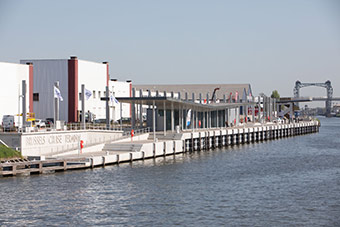With a quay 240 m long and 12 m wide, the "Brussels Cruise Terminal" is the Port of Brussels’ new passenger terminal. Developed as part of the Canal Plan, this project aims to ride the wave of cruise tourism development, while integrating the waterway into the urban fabric of Brussels. The Neder-Over-Heembeek green promenade is accessible from the terminal walkway. Cruises connect Brussels, Antwerp, Rotterdam and Amsterdam, as well as Brussels, Rupelmonde, Antwerp, Ghent, Bruges and Ostend.
- 14 August 2019
By building a passenger terminal, pedestrian bridge, riverbank, green shoreline and skate park, the project contributes to limiting the socio-economic and territorial polarisation of the canal area (at NOH). In addition, this project contributes to improving the quality of the surroundings by promoting tourism, an improved quality of life and urban integration within a green and sustainable context.
The ’Brussels Cruise Terminal: Urban integration of Brussels’ outer harbour’ project led by the Port of Brussels aims to reduce the socio-economic polarisation of the Neder-Over-Heembeek Canal (NOH) area and to improve the quality of the surroundings in this area. It also aims to promote tourism and the urban integration of port activities in a green and sustainable context.
Promote water tourism and soft mobility
With the construction of a passenger terminal near green spaces and recreational areas, the Port plans, on the one hand, to promote water tourism within the Brussels-Capital Region and, on the other, to create a place for residents to relax and enjoy leisure activities. In addition, thanks to a walkway, the project provides a better link between the NOH centre and the canal – a connection that, until now, has been almost non-existent. This leads to an enhancement of the area in favour of soft mobility.
Several projects have already been completed:
the construction of a quay for mooring different types of boats, such as canal cruise ships, day trip boats, and event boats; the construction of a pedestrian walkway linking the canal to NOH.In addition, work on an embankment began in August 2019. This work includes the development of a green shoreline, a pedestrian zone and a skate park. The work is scheduled to be completed by mid-2020.
Sustainable development of the area
The project will result in higher levels of aquatic and recreational tourism. It will also lead to improved mobility and connections between the NOH centre and the canal, as well as between the centre of Brussels and NOH. By promoting the use of waterways, it also contributes to the development of soft mobility in Brussels. In addition, the project participates in urban metabolism. Its design took into account the three pillars of sustainable development (ecological, social, economic). For example, sustainable lighting has been installed in the area, the fight against noise pollution has been taken into account, as has CO2 reduction by encouraging boat transport and cyclist and pedestrian traffic. Waterborne transport remains the most sustainable, reliable and safe mode of transport.
Total investment and European funding
Total investment for the ‘Brussels Cruise Terminal: Urban integration of the outer harbour of Brussels’ project was EUR 7 173 858; the European Regional Development Fund contributed EUR 1 434 675 through the ‘ERDF PO Brussels Capital Region/ EFRO OP Brussel Hoofdstedelijk Gewest’ operational programme for the 2014-2020 programming period. The investment is part of the ’Energy Union and Climate’ priority.

